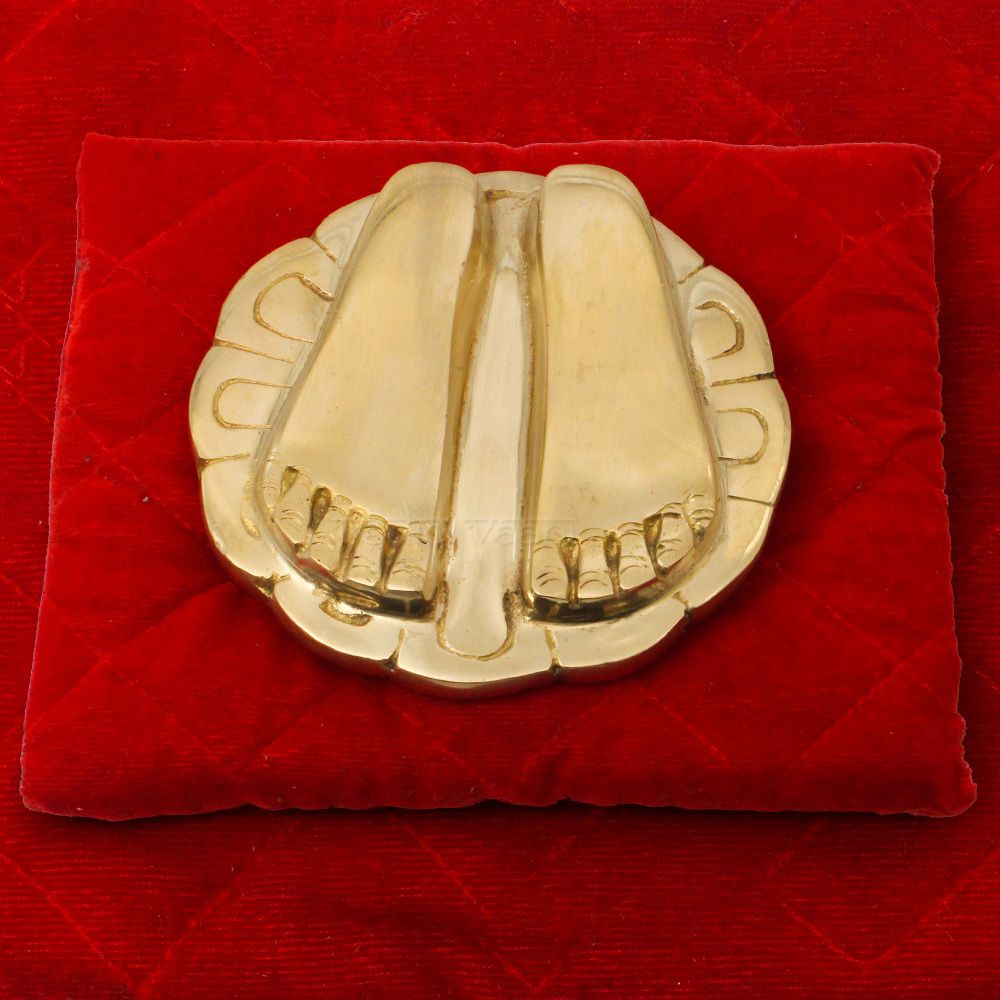Sacred Spiritual Devotion Spiritual Footprint Charan Paduka
$26.00
Charan Paduka represents the sacred feet of divine deities or revered Gurus in Hindu tradition. Worshipping Charan Paduka is symbolic of complete surrender and devotion to the divine. It is believed to bring spiritual blessings, protection, and guidance to the devotee. Placing Charan Paduka in your home, temple, or meditation space attracts positive energy, prosperity, and peace. It serves as a reminder to stay grounded in humility and devotion while walking the path of righteousness. Touching or offering prayers to the Charan Paduka invokes divine grace and strengthens spiritual connection.
Paduka also means foot prints of Hindu gods such as Vishnu, Shiva and several saints and masters that are worshipped in this symbolic form in houses and also in temples built for this purpose. One such temple is the Gaya temple dedicated to Vishnupada or Vishnu's feet. Similarly, Buddha's foot prints are worshipped under the Bodhi tree in Bodh Gaya.
Paduka is a compound word made up of two words namely, "pada" and "ka". In Sanskrit language, 'Pada' means: "foot" and "ka" is a diminutive ending with literal meaning of "small".
In Rigveda, it is quoted as representing the universe namely the Prithvi (earth), Vayu (air), Akash (sky) and the element of the realm beyond the sky. In the epic Ramayana, King Dasaratha who had a curse on him, sent his son Rama (an incarnation of god Vishnu) for 14 years of exile, at the behest of his wife Kaikeyi (step mother of Rama) as she wanted her son Bharata to be crowned as the king. Rama, his consort Sita and brother Laksmana went into a forest to spend their period of exile. But Bharata did not want to have the kingdom. He, therefore, met Rama who was living in the forest and beseeched him to return to Ayodhya. When Rama told Bharata that he will return only after completing his fourteen years in the forest, Bharata requested for Rama's paduka to serve as his proxy, to be crowned in Ayodhya Raj Singhasan (King's throne) of Kosala country and to serve as an object of veneration for Rama's followers. Bharata carried Rama's golden sandals (padukas) with great reverence by placing them on his head as a mark of his obedience to his elder brother. Bharata ruled Kosala as Rama's proxy in the name of "Ram's Padukas"
Design: Made of thick brass with long lasting finish.
Brass is well known for its grasping capacity. It grasps the divine spirit upto 30%, when compared to other metals. The spiritual vibrations are attracted towards these shining idols easily.
Dimensions: 4 inches (H) x 4 inches (W)
Weight: 425 gms
Paduka also means foot prints of Hindu gods such as Vishnu, Shiva and several saints and masters that are worshipped in this symbolic form in houses and also in temples built for this purpose. One such temple is the Gaya temple dedicated to Vishnupada or Vishnu's feet. Similarly, Buddha's foot prints are worshipped under the Bodhi tree in Bodh Gaya.
Paduka is a compound word made up of two words namely, "pada" and "ka". In Sanskrit language, 'Pada' means: "foot" and "ka" is a diminutive ending with literal meaning of "small".
In Rigveda, it is quoted as representing the universe namely the Prithvi (earth), Vayu (air), Akash (sky) and the element of the realm beyond the sky. In the epic Ramayana, King Dasaratha who had a curse on him, sent his son Rama (an incarnation of god Vishnu) for 14 years of exile, at the behest of his wife Kaikeyi (step mother of Rama) as she wanted her son Bharata to be crowned as the king. Rama, his consort Sita and brother Laksmana went into a forest to spend their period of exile. But Bharata did not want to have the kingdom. He, therefore, met Rama who was living in the forest and beseeched him to return to Ayodhya. When Rama told Bharata that he will return only after completing his fourteen years in the forest, Bharata requested for Rama's paduka to serve as his proxy, to be crowned in Ayodhya Raj Singhasan (King's throne) of Kosala country and to serve as an object of veneration for Rama's followers. Bharata carried Rama's golden sandals (padukas) with great reverence by placing them on his head as a mark of his obedience to his elder brother. Bharata ruled Kosala as Rama's proxy in the name of "Ram's Padukas"
Design: Made of thick brass with long lasting finish.
Brass is well known for its grasping capacity. It grasps the divine spirit upto 30%, when compared to other metals. The spiritual vibrations are attracted towards these shining idols easily.
Dimensions: 4 inches (H) x 4 inches (W)
Weight: 425 gms
| Show On Homepage | No |
|---|---|
| Short Description | Charan Paduka represents the sacred feet of divine deities or revered Gurus in Hindu tradition. Worshipping Charan Paduka is symbolic of complete surrender and devotion to the divine. It is believed to bring spiritual blessings, protection, and guidance to the devotee. Placing Charan Paduka in your home, temple, or meditation space attracts positive energy, prosperity, and peace. It serves as a reminder to stay grounded in humility and devotion while walking the path of righteousness. Touching or offering prayers to the Charan Paduka invokes divine grace and strengthens spiritual connection. Dimensions: 4 inches (H) x 4 inches (W) Weight: 425 gms |
We found other products you might like!
























